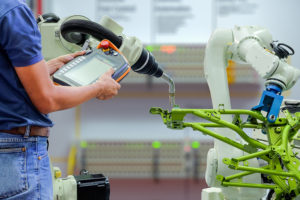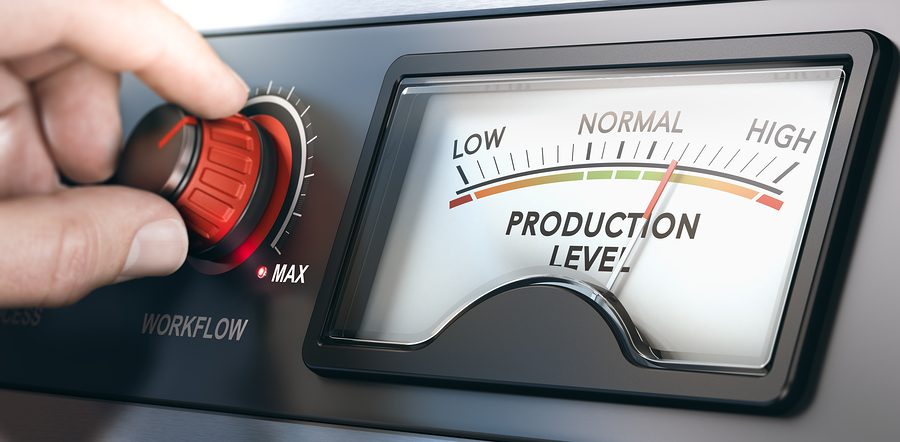It’s important for manufacturing leaders to view productivity not only as an important management concept but also an actionable tool that drives “efficient employees, equipment, and processes.” Fine-tuning processes and equipment operations is a good start to keep employees on track and productive; however, it often isn’t enough. Employing these steps can increase productivity, which helps to reduce waste, streamline operations, and encourage employees to take pride in their work. Make greater productivity a reality by employing these six easy-to-implement steps.
1. Know your starting point.
It’s hard to know where you’re going if you aren’t sure where to start. Well-drawn maps help plant leaders locate starting points and help manufacturing teams know what their end goals are and how to reach them. Create a productivity map charting current processes from design through production and on to shipping. Is sourcing necessary materials slowing you down or is downtime a problem on the production line? Do missed expectations create slowdowns?
A detailed map can include both tangible and intangible assets. Chart intangible needs like organizational communications and customer satisfaction so your teams’ insights aren’t limited. Develop a clearer understanding as to whether you are — or should be — satisfied with your throughput. Using industry standards as benchmarks can help you determine if you’re aiming too high or if there’s room for improvement. If you’re hitting profitability targets and other goals, great! If not, it could be time to go back to the drawing board.
2. Get buy-in.

Employees may shrug at efforts to boost productivity if they’ve been involved in half-hearted attempts in the past. If they feel as though no one has listened to their input before, keep in mind they likely won’t go all-in right out of the starting gate. You need to make believers of your team to see desired results and engagement.
Communicate why these efforts are important and how you’ll value employee efforts and feedback. Consider incentivizing innovative ideas small teams or individuals offer that reveal bottlenecks and offer steps to overcome them. High-performing employees who care about their teammates and offer innovative ideas are the foundation for productive operations.
3. Set goals.
Set specific goals to measure progress. One option is to set SMART goals that are simple, measurable, achievable, results-based, and time-sensitive. Be thoughtful and realistic, and clearly communicate these goals to your employees to ensure everyone is on the same page. Know these goals don’t have to be set in stone: Adjust them if they become too simple and easy to achieve or too difficult.
4. Smooth interpersonal communications.
You likely know how the telephone game starts — and ends — which illustrates how quickly communications can become misinterpreted and core messages lost. It’s not only important for manufacturing leaders to give clear instructions but they must also follow up to ensure employees understand what they say.
Setting expectations in terms of end goals is also important so employees know what they’re working toward — rather than just what they’re working on at any given time. One way to ensure clear communication is by eliminating clutter: In the same way you get rid of unnecessary tools, don’t burden others with unnecessary directives. In addition, make it easy for manufacturing personnel on the plant floor to ask questions, especially if they need to clarify instructions or gain a better understanding of next steps.

5. Use smart machines.
Manufacturers are building “smart” plants for good reason: Automating processes and upgrading equipment like robotics are ways to quickly enhance productivity. It’s important to understand that the tools and people working with them enhance one other’s productivity through collaboration. The right tools can create efficiencies when people who understand the entire process program and use them safely and effectively.
6. Prevent breakdowns and maintain equipment.
Don’t let unexpected shutdowns slow you down. Searching for an equipment repair specialist shouldn’t be part of the process when you need fixes fast to keep productivity high. While it’s usually not feasible to employ full-time troubleshooting and maintenance staff members, manufacturers still need equipment repairs done quickly and correctly. Having a go-to source to prevent breakdowns and ensure equipment is functioning smoothly is a critical part of the productivity puzzle.
Ready to increase productivity and enhance efficiency in your manufacturing plant? All it takes is some advanced planning and continued focus on your goals. Begin by establishing where your manufacturing plant is now, then decide where you’d like to go. These tips can give you a great head start!
Call us at 1-877-249-1701 or contact us online for all your electronic maintenance and repair needs, and be sure to like and follow us on Facebook!
